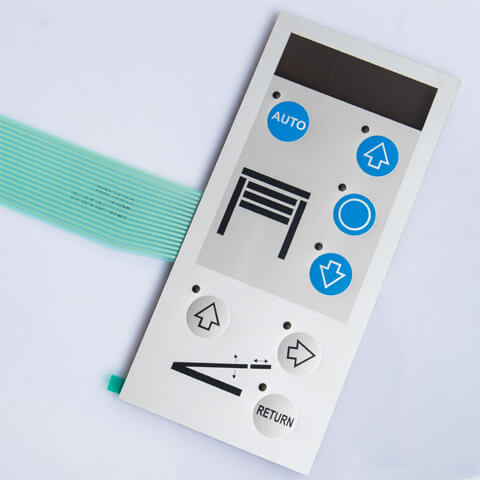The Role of Membrane Switches in Improving Product Durability and Performance
Checking Out the Perks of Membrane Layer Changes for Modern Electronic Devices
The exploration of membrane layer buttons in contemporary digital gadgets uses an interesting viewpoint on their myriad benefits, especially in regards to design adaptability, sturdiness, and cost-effectiveness. These interfaces not only withstand extreme ecological conditions however likewise supply a high degree of customization, which is significantly important in today's open market. As industries continue to progress, the function of membrane layer buttons in enhancing customer experience and functional efficiency warrants better exam. Understanding how these elements can form the future of digital applications might disclose insights that could influence design and production approaches significantly.
Advantages of Membrane Switches
Membrane layer switches are progressively favored in modern electronics because of their numerous benefits. Among the main advantages is their small design, which enables space-efficient assimilation into different tools. This slim profile not only preserves area yet additionally adds to the total visual charm of electronic items.
One more benefit is their toughness. Membrane layer buttons are commonly resistant to dampness, dirt, and impurities, making them ideal for usage in settings where direct exposure to rough problems is a problem. This resistance expands the life expectancy of the switches, lowering the need for frequent replacements and upkeep.
Moreover, membrane changes offer superb tactile feedback, enhancing user experience. The tactile response is commonly developed to supply an enjoyable feeling upon activation, which can improve individual complete satisfaction and performance.
Additionally, the production procedure of membrane buttons is affordable, permitting for lower production prices contrasted to standard mechanical buttons. This price makes them ideal for a vast array of applications, from customer electronic devices to commercial machinery.
Style Adaptability and Personalization
The design versatility and customization choices supplied by membrane layer switches better enhance their appeal in contemporary electronic devices. These switches can be customized to meet particular visual and practical demands, allowing makers to produce devices that straighten closely with brand identity and customer choices. With numerous options in terms of shades, forms, and dimensions, membrane layer switches can seamlessly integrate into diverse product styles, whether for customer electronics, industrial applications, or clinical gadgets.
In addition, the ability to incorporate graphics and symbols directly onto the button surface area enhances functionality while lowering the need for extra labeling. This integration not just simplifies production processes however also adds to a sleeker general look. The layout can be further personalized through attributes such as backlighting, tactile feedback, and multi-layer building and constructions, offering boosted user interaction.

Toughness and Environmental Resistance

Additionally, membrane layer buttons can be engineered to be chemically resistant, making them appropriate for applications in industrial environments where exposure to solvents and anonymous cleansing representatives is common. The encapsulation of electronic components within the membrane layer structure provides added defense against environmental tensions, making certain trustworthy performance even in challenging conditions.
In addition to physical durability, membrane changes display exceptional resistance to UV light, preventing degradation and discoloration with time (membrane switch). This particular is specifically valuable for outside applications, where extended exposure to sunshine can jeopardize various other button types
Eventually, the durability and environmental resistance of membrane layer changes make them an optimal selection for a large range of modern-day electronic devices, from medical devices to customer electronic devices, ensuring regular capability and individual satisfaction throughout various applications.
Cost-Effectiveness in Manufacturing
Cost-effectiveness in production is a substantial benefit of membrane layer find out switches, making them a recommended choice for makers in various markets. The production procedure of membrane layer changes normally involves less products contrasted to traditional switches, which reduces basic material prices. This streamlined manufacturing process not only saves cash but also minimizes waste, aligning with modern sustainability goals.
Moreover, membrane buttons can be created utilizing automated strategies, enabling high-volume result with decreased labor expenses. The integration of sophisticated printing innovations further improves efficiency, enabling producers to accomplish detailed designs and capabilities without sustaining significant additional expenditures. This scalability ensures that manufacturing can adapt to altering market needs without endangering quality or enhancing costs.

Additionally, the lightweight nature of membrane changes adds to set you back financial savings in shipping and handling, as well as in the overall style of electronic tools. By getting rid of bulky parts, producers can enhance the general item design, consequently improving market competitiveness. Overall, the cost-effectiveness of membrane switches not only advantages makers financially however likewise facilitates technology check this site out and rapid product development in the vibrant landscape of contemporary electronics.
Applications in Numerous Industries
Adaptability sticks out as a characteristic of membrane switches, allowing them to locate applications across a broad array of markets. In the healthcare industry, these buttons are essential to clinical tools, providing straightforward user interfaces for equipment like mixture pumps and analysis machines. Their resistance to dampness and simple cleaning make them ideal for atmospheres requiring stringent hygiene standards.
In the auto sector, membrane layer buttons add to the performance of dashboards and control panels, supplying a streamlined, modern-day look while making certain sturdiness versus severe problems. Their light-weight design additionally sustains overall lorry effectiveness.

Furthermore, industrial machinery employs membrane layer buttons for functional controls. Their robust nature and personalized attributes accommodate the particular requirements of varied applications.
Final Thought
To conclude, membrane changes offer considerable benefits for modern-day electronics, including style flexibility, sturdiness, and cost-effectiveness. membrane switch. Their customizable attributes and resistance to ecological factors make them appropriate for a wide range of applications across different markets. As technical demands continue to develop, the adaptability and efficiency of membrane layer switches position them as a crucial part in improving individual experience and driving technology within the affordable landscape of electronic devices